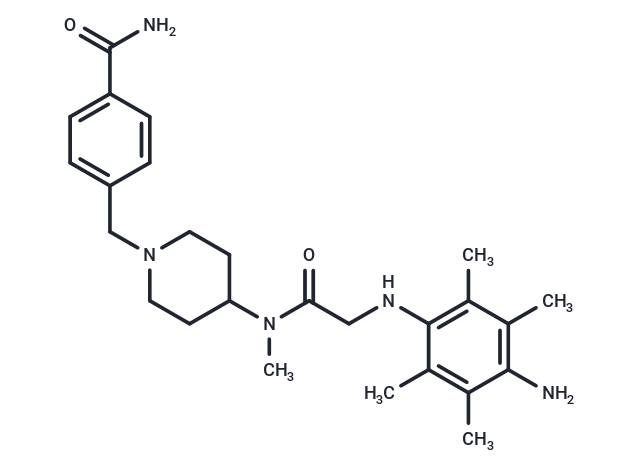Shopping Cart
- Remove All
 Your shopping cart is currently empty
Your shopping cart is currently empty

SUN11602, an aniline compound, mimics the neuroprotective mechanisms of basic fibroblast growth factor. It mimics the neuroprotective effects of bFGF and prevents glutamate-induced neuronal death. It also increases levels of CALB1 gene expression in cerebrocortical neurons and triggers phosphorylation of FGFR and ERK1/2.

| Pack Size | Price | Availability | Quantity |
|---|---|---|---|
| 5 mg | $55 | In Stock | |
| 10 mg | $97 | In Stock | |
| 25 mg | $198 | In Stock | |
| 50 mg | $328 | In Stock | |
| 100 mg | $409 | In Stock | |
| 1 mL x 10 mM (in DMSO) | $61 | In Stock |
| Description | SUN11602, an aniline compound, mimics the neuroprotective mechanisms of basic fibroblast growth factor. It mimics the neuroprotective effects of bFGF and prevents glutamate-induced neuronal death. It also increases levels of CALB1 gene expression in cerebrocortical neurons and triggers phosphorylation of FGFR and ERK1/2. |
| In vitro | Physiological actions of SUN11602 mimic several phenomena of the neuroprotection that is induced by bFGF. SUN11602 plays a pivotal role in allowing primary cultured neurons to survive in adverse environments of glutamate toxicity and activating intracellular key molecules that are involved in the neuroprotective mechanisms. These actions are quite similar to those of bFGF. Such neuroprotective mechanisms are specific and distinctive to SUN11602 and bFGF and differs clearly from those of the other growth factors that are investigated. But unlike bFGF, SUN11602 can either directly or indirectly trigger the phosphorylation of the cytosolic domain of the FGFR without binding to the extracellular domain of the FGFR-1[1]. SUN11602 demonstrates no cell proliferative activity of somatic cells, unlike bFGF. SUN11602 significantly affects neuronal survival in adverse conditions through a FGFR1-mitogen-activated protein kinase/extracellular signal-regulated kinase-1/2 kinase (FGFR-1–MEK/ERK) signaling pathway[2]. |
| In vivo | In WT mice, SUN11602 and bFGF increase the levels of newly synthesized Calb in cerebrocortical neurons and suppress the glutamate-induced rise in intracellular Ca2+. This Ca2+-capturing ability of Calb allows the neurons to survive severe toxic conditions of glutamate. In contrast, Calb levels remain unchanged in Calb-/- mice after exposure to SUN11602 or bFGF, and due to a loss of function of the gene, these neurons are no longer resistant to toxic conditions of glutamate[1]. Neuroprotective activities of SUN11602 and FGF-2 are due to exogenously induced hyperexpression of CalB in hippocampal neurons. The pharmacokinetic properties of SUN11602 appear to hold promise in terms of bioavailability (>65%) after oral administration in rodents (rats and mice) and dogs (beagles)[2]. |
| Cell Research | Actinomycin D or cycloheximide is first added to the cultures, and, 2 h later, SUN11602 or bFGF is added. After a 24 h incubation, neurons in the cultures are exposed to 150 μM glutamate for another 24 h, and cell viability is determined by a (3-(4,5-dimethyl-2-thiazolyl)-2,5-diphenyl-2H tetrazolium bromide (MTT) assay.(Only for Reference) |
| Alias | SUN 11602 |
| Molecular Weight | 451.6 |
| Formula | C26H37N5O2 |
| Cas No. | 704869-38-5 |
| Smiles | CN(C1CCN(Cc2ccc(cc2)C(N)=O)CC1)C(=O)CNc1c(C)c(C)c(N)c(C)c1C |
| Relative Density. | 1.19 g/cm3 (Predicted) |
| Storage | Powder: -20°C for 3 years | In solvent: -80°C for 1 year | Shipping with blue ice. | |||||||||||||||||||||||||||||||||||
| Solubility Information | Ethanol: 9 mg/mL (19.93 mM), Sonication is recommended. DMSO: 40 mg/mL (88.57 mM), Sonication is recommended. | |||||||||||||||||||||||||||||||||||
Solution Preparation Table | ||||||||||||||||||||||||||||||||||||
Ethanol/DMSO
DMSO
| ||||||||||||||||||||||||||||||||||||

Copyright © 2015-2025 TargetMol Chemicals Inc. All Rights Reserved.